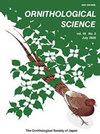Usage of Urban Rivers by Gulls and Cormorants as Movement Pathways in Winter
IF 0.3
4区 生物学
Q4 ORNITHOLOGY
引用次数: 2
Abstract
Abstract For the long-term survival of bird populations in urban areas, it is necessary to protect both bird habitats fragmented by urbanization and potential pathways for movement between them. However, urban pathways for waterbirds have rarely been studied. Suspecting that certain waterbird species that visit inland waters would tend to move along rivers, as movement pathways, we surveyed waterbird movement along the Kanda River in Tokyo, Japan in the winter of 2017/2018. We defined those species that very frequently (more than 95% of all flights) flew along the river as “river travelers”. Three species, Great Cormorant Phalacrocorax carbo, Black-headed Gull Larus ridibundus, and Herring Gull L. argentatus proved to be river-dependent movers that frequently used the Kanda River as a pathway. The gulls relied more heavily on the river as a movement pathway than the cormorant. In this sense, urban rivers may play a role for these species that is analogous to that of linear vegetated spaces for terrestrial birds. In addition, the distribution of river travelers (especially Black-headed Gull) may have been affected by the extent of riverside vegetation alongside, and highways covering, the river. To protect movement pathways for gulls and cormorants in urban areas, it is necessary to consider the differences among bird species in terms of their relative dependence on urban rivers as movement pathways and their comparative susceptibilities to the impact of manmade structures covering the rivers.海鸥和鸬鹚在冬季利用城市河流作为迁徙路径
为了城市鸟类的长期生存,既要保护因城市化而破碎化的鸟类栖息地,也要保护它们之间潜在的迁徙路径。然而,水鸟在城市的迁徙路径却很少被研究。我们怀疑某些到达内陆水域的水鸟会倾向于沿着河流移动,作为移动路径,我们在2017/2018年冬季调查了日本东京神田河沿岸的水鸟运动。我们将那些非常频繁(超过95%的航班)沿着河流飞行的物种定义为“河流旅行者”。大鸬鹚Phalacrocorax carbo,黑头鸥Larus ridibundus和银鸥L. argentatus被证明是河流依赖的迁徙者,经常使用神田河作为路径。与鸬鹚相比,海鸥更依赖河流作为移动路径。从这个意义上说,城市河流对这些物种的作用可能类似于陆生鸟类的线性植被空间。此外,河流旅行者(尤其是黑头鸥)的分布可能受到沿河植被和公路覆盖范围的影响。为了保护海鸥和鸬鹚在城市地区的迁徙路径,有必要考虑不同鸟类对城市河流作为迁徙路径的相对依赖性以及它们对覆盖河流的人工结构影响的相对敏感性的差异。
本文章由计算机程序翻译,如有差异,请以英文原文为准。
求助全文
约1分钟内获得全文
求助全文
来源期刊

Ornithological Science
ORNITHOLOGY-
CiteScore
1.20
自引率
0.00%
发文量
26
审稿时长
>12 weeks
期刊介绍:
Ornithological Science publishes reviews, original articles, short communications and comments covering all aspects of ornithology. Manuscripts are judged on the basis of their contribution of original data and ideas or interpretation. All articles are peer-reviewed by at least two researchers expert in the field of the submitted paper. Manuscript are edited where necessary for clarify and economy. Ornithological Science aims to publish as rapidly as is consistent with the requirements of peer-review and normal publishing constraints.
 求助内容:
求助内容: 应助结果提醒方式:
应助结果提醒方式:


